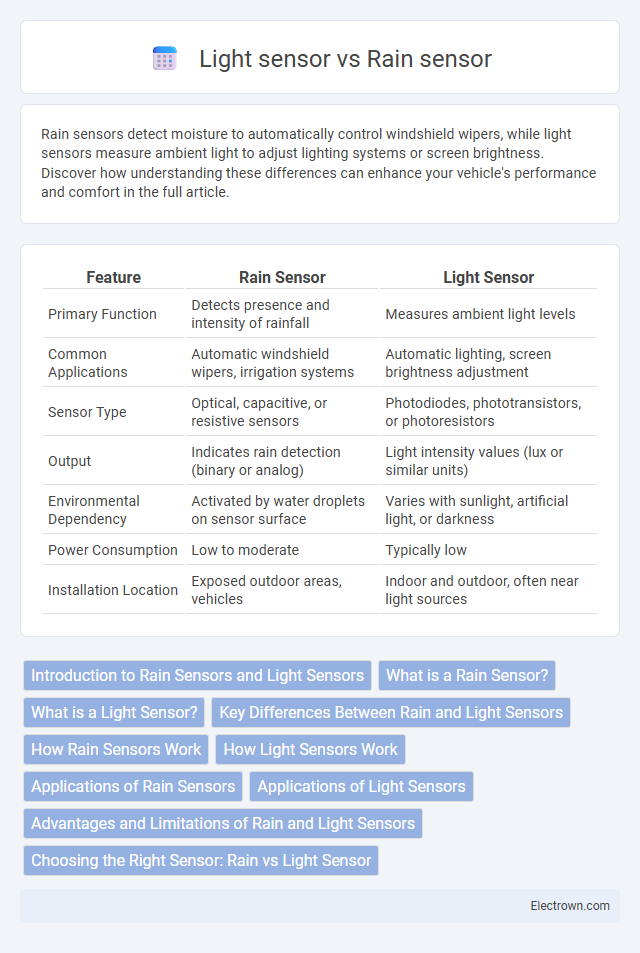Rain sensors detect moisture to automatically control windshield wipers, while light sensors measure ambient light to adjust lighting systems or screen brightness. Discover how understanding these differences can enhance your vehicle's performance and comfort in the full article.
Table of Comparison
| Feature | Rain Sensor | Light Sensor |
|---|---|---|
| Primary Function | Detects presence and intensity of rainfall | Measures ambient light levels |
| Common Applications | Automatic windshield wipers, irrigation systems | Automatic lighting, screen brightness adjustment |
| Sensor Type | Optical, capacitive, or resistive sensors | Photodiodes, phototransistors, or photoresistors |
| Output | Indicates rain detection (binary or analog) | Light intensity values (lux or similar units) |
| Environmental Dependency | Activated by water droplets on sensor surface | Varies with sunlight, artificial light, or darkness |
| Power Consumption | Low to moderate | Typically low |
| Installation Location | Exposed outdoor areas, vehicles | Indoor and outdoor, often near light sources |
Introduction to Rain Sensors and Light Sensors
Rain sensors detect moisture on surfaces to automatically control irrigation systems or windshield wipers, enhancing efficiency and safety. Light sensors measure ambient light intensity, enabling devices like smartphones and outdoor lighting to adjust brightness and conserve energy. Understanding the distinct functions of rain and light sensors helps you choose the right technology for automation and environmental responsiveness.
What is a Rain Sensor?
A rain sensor detects rainfall by using either optical or moisture-sensing technology to automatically control systems like windshield wipers or irrigation. Unlike a light sensor that measures ambient light levels to adjust brightness or lighting conditions, a rain sensor specifically responds to precipitation to protect or optimize your equipment. Your vehicle or garden system benefits from precise activation only when rain is present, enhancing efficiency and convenience.
What is a Light Sensor?
A light sensor is a device that detects and measures the intensity of ambient light, converting it into an electrical signal for various applications. Commonly used in smartphones, automatic lighting systems, and security devices, it helps optimize energy use by adjusting brightness levels based on surrounding light conditions. Understanding how a light sensor functions can enhance your control over lighting environments and improve the efficiency of your electronic devices.
Key Differences Between Rain and Light Sensors
Rain sensors detect moisture by measuring the presence or amount of water on a surface, primarily used to automate windshield wipers or irrigation systems. Light sensors measure ambient light intensity and adjust lighting or screen brightness accordingly in environments such as smart homes or electronic devices. The key difference lies in their sensing targets--rain sensors respond to liquid precipitation, while light sensors respond to electromagnetic radiation in the visible spectrum.
How Rain Sensors Work
Rain sensors detect moisture through either a conductive or optical method, triggering automatic responses such as closing windows or pausing irrigation systems to prevent water damage or overwatering. Conductive rain sensors utilize electrodes to sense the presence of water by measuring electrical conductivity differences on the sensor surface. Optical rain sensors emit infrared light at an angle; when raindrops refract or scatter the light, the sensor detects the change and signals the system accordingly.
How Light Sensors Work
Light sensors detect ambient light intensity by converting light photons into an electrical signal through photodiodes or phototransistors, allowing your device to adjust brightness based on surrounding conditions. Unlike rain sensors that rely on moisture detection, light sensors continuously measure luminance levels to optimize screen visibility or trigger automatic lighting controls. Their sensitivity to various light wavelengths ensures precise environmental responsiveness, enhancing your device's performance and energy efficiency.
Applications of Rain Sensors
Rain sensors are primarily used in automotive systems to automatically activate windshield wipers, enhancing driver safety and convenience during rainfall. In irrigation systems, rain sensors prevent overwatering by detecting moisture, promoting water conservation and efficient landscape management. Building automation also utilizes rain sensors to close windows and retract awnings, protecting interior spaces and reducing maintenance costs.
Applications of Light Sensors
Light sensors are widely used in applications such as automatic lighting control, where they adjust indoor and outdoor lighting based on ambient light levels to save energy and enhance comfort. They play a crucial role in smart devices for screen brightness adjustment, ensuring optimal visibility while reducing eye strain. Your security systems also benefit from light sensors by detecting changes in lighting conditions to trigger alarms or activate cameras.
Advantages and Limitations of Rain and Light Sensors
Rain sensors offer precise detection of moisture, enabling automatic activation or deactivation of irrigation systems to conserve water and prevent overwatering, but they can be less effective in scenarios with light drizzle or mixed precipitation. Light sensors efficiently regulate lighting systems by adapting to ambient brightness, enhancing energy savings and user comfort, though their performance may be compromised by shadows or sudden light changes. Both sensors contribute to smart automation but require calibration and environmental consideration to maximize reliability and accuracy.
Choosing the Right Sensor: Rain vs Light Sensor
Choosing the right sensor depends on your specific application needs; a rain sensor detects moisture to automate windshield wipers or irrigation systems, enhancing efficiency during wet conditions. A light sensor measures ambient light levels, optimizing lighting control for energy savings and improved visibility in indoor or outdoor environments. Your decision should focus on whether monitoring precipitation or light intensity aligns better with your automation goals and environmental conditions.
Rain sensor vs Light sensor Infographic

 electrown.com
electrown.com